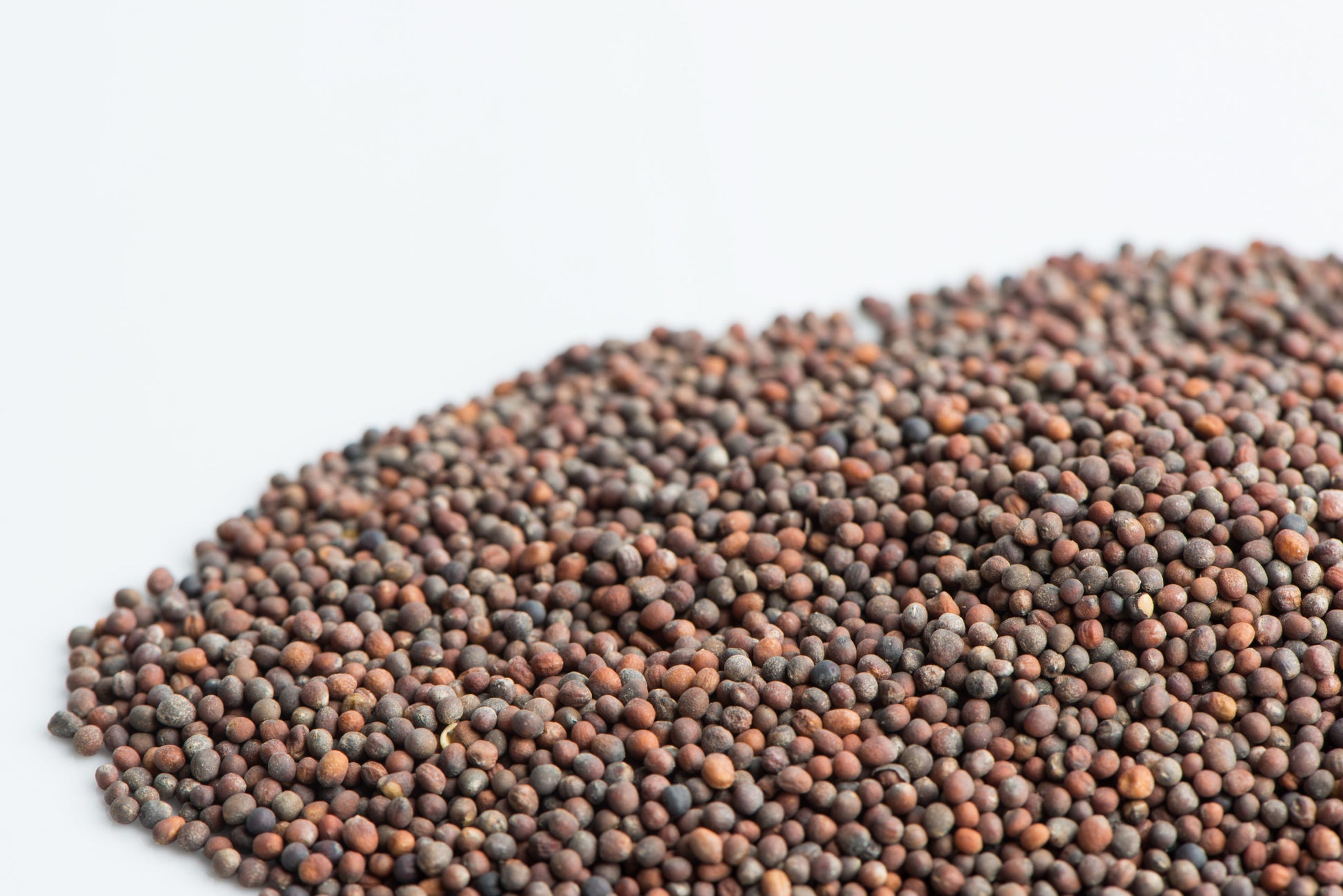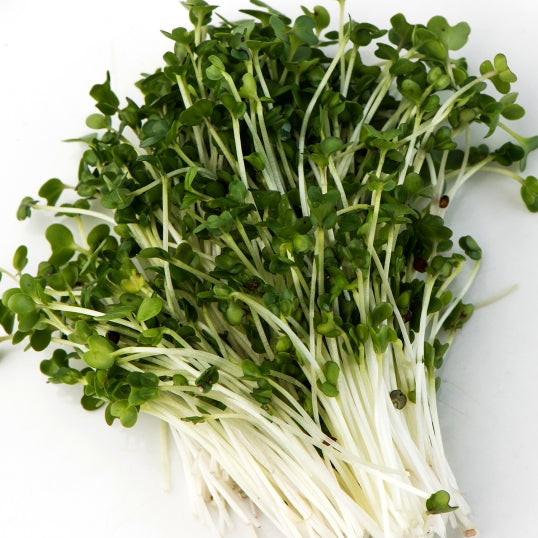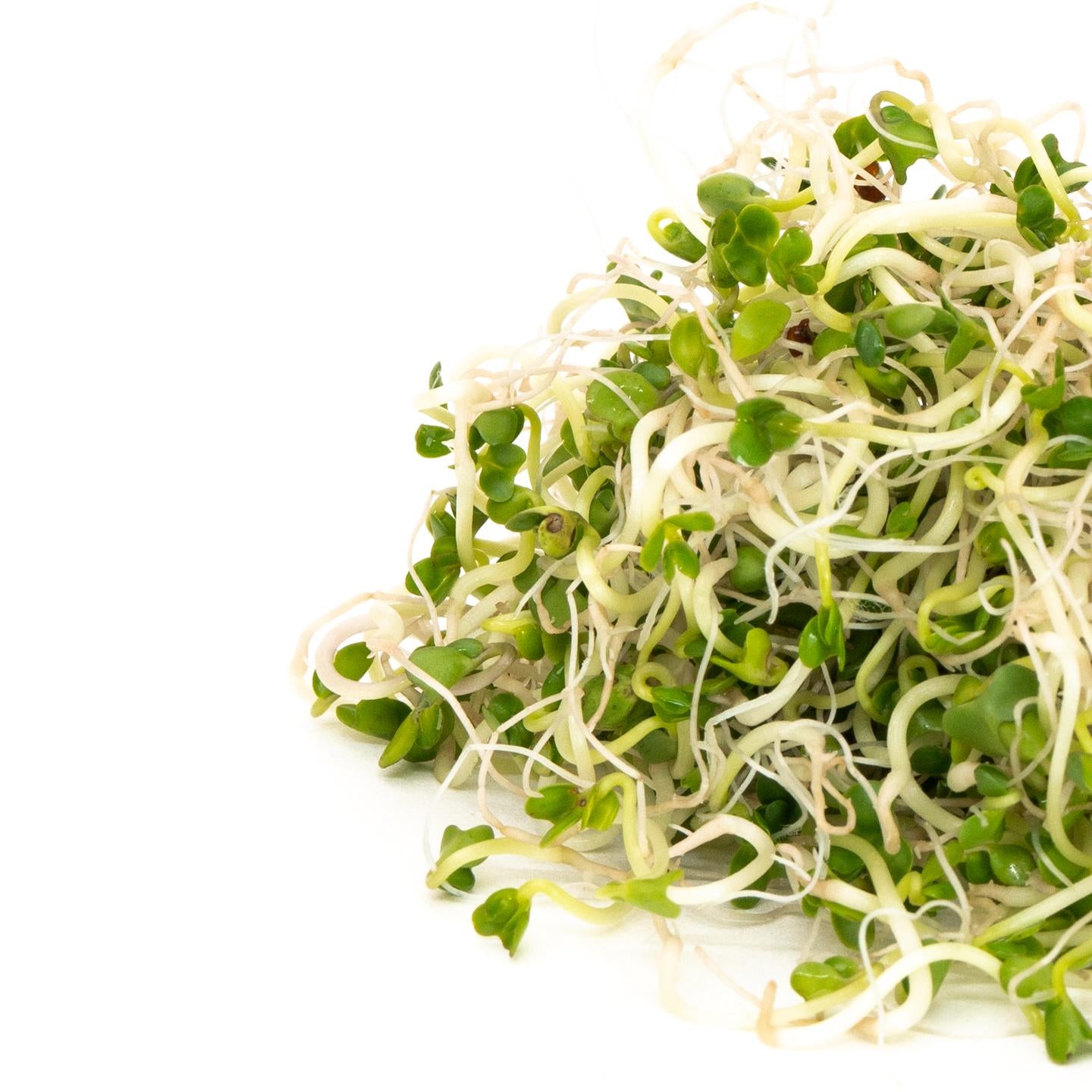Broccoli
Broccoli
Couldn't load pickup availability
SOAK 1-2 HOURS ONLY. Drain very well.
Seed appearance can vary from photo lot to lot. This can change frequently.
- Days to Sprout: Sprout- 4-5, Microgreen- 7-10
- Soak Time: 1-2 hours
- Yield: 1 tbsp of dry seed yields approx. 1 cup of sprouts.
- Storage: Our seeds should sprout well for a year after you purchase them, if stored in a cool dry place. If you'd like to extend the germination life of your seeds, store them in the fridge. If you store your seeds in the freezer, they'll last even longer!
Sprouting Directions
Soak: Put 1-2 Tbsp. seed in a wide mouth jar with a sprouting lid. Add water, swirl, and drain. Refill jar with water and soak 1-2 hours. (Soaking broccoli for longer than 2 hours can cause it to lose germination.) Drain well and invert jar at an angle on a sprouting rack, in a bowl or drain rack.
TIP: After draining, tap the jar gently to remove excess moisture. Rotate the jar and tap gently a few more times.
Rinse: Twice a day, refill jar with cold water, swirl, and drain well by tapping excess water from jar.
Enjoy! Ready to eat in 5 days. Refrigerate to store. (Sprouts store best when they are fairly dry.)
Growing Directions
Growing Directions
Sprouting Directions:
Soak: Put 1-2 Tbsp. seed in a wide mouth jar with a sprouting lid. Add water, swirl, and drain. Refill jar with water and soak 1-2 hours. (Soaking broccoli for longer than 2 hours can cause it to lose germination.) Drain well and invert jar at an angle on a sprouting rack, or in a bowl or drain rack.
TIP: After draining, tap the shake the jar gently to remove excess moisture. Rotate the jar and tap gently a few more times.
Rinse: Twice a day, refill jar with cold water, swirl, and drain well by tapping excess water from jar.
Enjoy! Ready to eat in 5 days. Refrigerate to store. (Sprouts store best when they are fairly dry. If you need to store immediately after rinsing, spin dry first.)
Helpful tips:
• Some sprouts tend to clump together as they grow. To separate, fill the jar with water, remove the screen and stir gently with a fork during the regular rinse. Remove hulls if desired. Drain well as usual.
• The drier they are the better sprouts keep. Be sure to let sprouts grow another half day after the final sorting rinse before storing in the fridge. Optional: put folded paper towel on top of the sprouts in the jar. Put lid on and refrigerate turned upside down. This removes excess moisture.
• If your home is very warm during the summer months, it may help to rinse the sprouts three times a day with cold water. Stir gently if clumping.
• To remove the hulls and unsprouted seeds from leafy sprouts, use a special sorting rinse. Pull sprouts out of the jar into a large bowl filled with water. Swish gently using fingers to separate the tangled roots. Most hulls will separate and rise or sink. Discard the hulls. Collect the sprouts back to the jar with or without aid of a strainer. Return the sprouting closure and drain so you can continue for half a day more of sprouting.
• Some brassicas (cabbage family) like radish and broccoli develop very fuzzy root hairs the longer you leave them undisturbed and these can be mistaken for mould. You will even see these after a few days of storage in the fridge. Stirring and rinsing removes the root hairs for a time.
Microgreen Directions(No Soil):
Soak: Using a tray with drainage holes, rinse enough seed to cover the bottom of the tray. Soak the seed for 1-2 hours. Use a jar with a sprouting lid for soaking if the tray holes are too large. Drain, rinse and drain holding at an angle to remove excess water. Spread the seed evenly on the bottom of the tray and cover with a lid top and bottom or put in plastic bag.
Rinse: Rinse with cold water twice a day, using either a gentle flow from a tap, dipping in a sink, or spraying. Drain thoroughly.
Grow. The roots will form a mat from which the microgreens will emerge. At that point, put in indirect sunlight, florescent/LED lights or grow lights. The watering is then easy: fill the container 1 cm deep with water and allow to sit for a few seconds in the water and then tilt on an angle to decant the water until only some moisture is remaining in the root area. Continue to rinse twice a day as described above.
Harvest!
Typically, microgreens grown without soil are harvested at 7-10 days. Harvest before the next expected rinse so the shoots are dry. Harvest before the next expected rinse so the shoots are dry. Harvest microgreens using scissors or knife.
Instead of harvesting all at once, you can start to harvest microgreens as soon as the first two leaves are spread out. Take only what you need for your meal and allow the rest to keep growing or put the tray in the fridge loosely covered and a plastic bag or dome to harvest another day.
Microgreen Directions (Soil):
• 10” x 20” gardening trays (1-inch-tall preferred), 1 with
holes + 1 without. Smaller microgreen trays also work well.
• Good quality organic starting soil mix
• Parchment paper or unbleached paper towel (optional).
• Dome lids (clear or black) or plastic sheet
• Organic seed
• Mister bottle, cup measures, garden spray nozzle (optional)
• Scissors or sharp knife
1. Don’t soak small or medium size seed. Small seed such as broccoli and arugula are easier to sprinkle on top of the soil if they are not soaked.
2. Prepare Soil
Add water to top of the bag (or each tray) 12 hours ahead of use until almost fully hydrated. Rehydrate the bag as necessary. If you were to put the soil in your hand and squeeze it, you should not be able to get much more than a drop of water out of it for the perfect moisture content. If you want to mist the seed after putting it on the soil, reduce the water hydration of the bagged soil a bit.
TIP: To check for overwatering, tip the tray to one end. Water should not pool enough to drip out of the tray.
3. Fill Trays with Soil
Use a tray with holes. Fill with 3/4-1.5” of soil. The closer to the top of the tray the better aid to air circulation. Use a block or your hand to smooth and flatten the soil without compacting it. The back of a tablespoon or spatula smooths out the valleys. You can wait to put the tray without holes under until after unstacking/uncovering or add it to the bottom now.
TIP: Place a layer or two of paper towel on the bottom of the tray before adding soil for easier cleanup.
4. Sow the Seed
Sprinkle the seed evenly over the soil in the tray (pizza cheese shaker, spoon). The seeding density depends on the stage at which you’re planning to harvest. For small seeds for 1-week microgreens, start with approximately 15 -28 grams (1.5 - 2 Tbsp). Sow slightly less seed for 2-3 week microgreens.
Seeds do not need misting if the soil has enough moisture. Mist if you need more moisture. Use a spray bottle or a garden spray nozzle set to light mist. The soil should be moist throughout, but not soaking wet.
5. Cover the Seed
Doing away with soil as a seed cover decreases the work and time it takes to grow the greens. If stacking the trays on top of each other, use a cover directly on the seed like parchment paper, a plastic sheet or wet unbleached paper towel layer. When not stacking trays, the seed will need protection from drying out by using a dome/lid. Use a clear dome or an inverted 10 x 20” tray without holes. For smaller trays, use several layers of unbleached paper towels folded onto itself with or without a plastic sheet covering the top.
TIP: Most microgreens will grow taller when you keep the light out at the beginning, but this may make the stem weaker. Most seeds germinate in the light no problem.
6. Stack Trays or Cover with Lids
Stacking helps to quickly force the roots into the soil, provides darkness, promotes even germination/growth. Stack 2-5 filled trays on top of each other with an empty tray on the top of the stack with a weight in it. Check at least once a day to see if the trays need water. Cabbage family seed sprouts quickly, so stack for 2-3 days. Others stack 3-5 days.
If choosing not to stack, simply cover the trays with clear or black-out plastic, a lid or dome. Check at least once a day to see if the trays need water. Cover for the same number of days as above.
7. Expose to Indirect Sunlight, Florescent/LED or Grow Lights.
After 2-5 days, the microgreens should be ready for light. If the microgreens begin to get quite tall and leggy, this is an indication that they may need a bit more light.
8. Water the Growing Microgreens
Check the seed once or twice daily and water as needed. The soil should be moist, not wet. Once trays are unstacked, add water from below into the no holes tray as necessary.
9. Harvest!
Microgreens are harvested at 1-3 weeks with scissors or a sharp knife. Make sure microgreens are not damp before storing. If needed, you may use a small fan or salad spinner to dry the microgreens before storing in a sealed container in the fridge.
Instead of harvesting all at once, you can start to harvest microgreens as soon as the first two leaves are spread out. Take only what you need for your meal and allow the rest to keep growing or put the tray in the fridge loosely covered and a plastic bag or dome to harvest another day. Water as necessary.
10. Enjoy!
Microgreens make everything better, so have fun with them and add them to your favourite dishes!
Helpful tips:
• To moisten your bag of soil, add water ahead until almost fully hydrated.
• The roots grow under the soil so it works well to water from below if the tray has holes in it, or open the side of the tray and pour water beside the soil when using flexible plastic trays. Otherwise misting or watering from the top works well too.
Jar Method: SOAK- Put 1 to 2 Tbsp. seed in a wide mouth jar. Cover with mesh and secure with rubber band. Add water | swirl | and drain. Add 1 cup cool water and soak for 1-2 hours. (Soaking broccoli for longer than 2 hours can cause it to loose germination.) Drain well. RINSE - Twice a day | refill jar with cool water | swirl | and drain very well by tapping and banging. Invert jar and prop at an angle in a sink or bowl. ENJOY - Ready to eat in 4 to 5 days. Refrigerate to store. (Sprouts store best when they are fairly dry- do not store immediately after rinsing.)
Tray Method: SOAK- Cover the bottom of the sprouting tray with soil or baby blanket. Moisten the growing medium. Sprinkle on dry broccoli seed and mist with spray bottle .WATER - Twice a day | rinse the seeds. Either rinse under a tap of running water | or use a spray bottle to mist well. Tip the tray to the side to drain well. ENJOY - Ready to eat in 7 to 10 days. Using sharp knife or clean scissors | cut above the soil bed. Refrigerate to store. Sprouts can be refrigerated for up to two weeks in a sealed container. (Sprouts store best when they are fairly dry- do not store immediately after rinsing.)
Best Growing Methods
Best Growing Methods
Jar Sprouting
Tray
Easy Sprouter
soil
Did You Know
Did You Know
Nutritional Information
Nutritional Information
“OBJECTIVE: To investigate whether sulforaphane (SFN), an isothiocyanate derived from cruciferous vegetables such as broccoli, regulates synoviocyte hyperplasia and T cell activation in rheumatoid arthritis (RA).
…..
CONCLUSION: SFN was found to inhibit synovial hyperplasia, activated T cell proliferation, and the production of IL-17 and TNFalpha by rheumatoid T cells in vitro. The antiarthritic and immune regulatory effects of SFN, which were confirmed in vivo, suggest that sulphoraphane may offer a possible treatment option for rheumatoid arthritis.”
Inhibition of synovial hyperplasia, rheumatoid T cell activation, and experimental arthritis in mice by sulforaphane, a naturally occurring isothiocyanate.
Arthritis Rheum. 2009 Dec 28;62(1):159-170.
Kong JS, Yoo SA, Kim HS, Kim HA, Yea K, Ryu SH, Chung YJ, Cho CS, Kim WU.
“Eating a daily portion of broccoli sprouts could help tame the H. pylori bacteria, linked to stomach ulcers and even cancer, research suggests.
The study in Cancer Prevention Research of 50 people in Japan found eating 2.5 ounces of broccoli sprouts each day for two months may confer some protection.”
BBC News
6 April 2009
Baby broccoli controls ‘gut bug’
http://news.bbc.co.uk/2/hi/health/7981095.stm
“People with nasal allergies or asthma may want to add broccoli sprouts to their diets, if early research findings pan out.
In a study of 65 healthy volunteers, researchers found that an oral preparation made from broccoli sprouts trigger an increase in inflammation-fighting enzymes in the upper airways.
The credit appears to go to a compound called sulforaphane, which is found naturally in broccoli and other cruciferous vegetables like Brussels sprouts, cauliflower and cabbage.
Sulforaphane triggers an increase in antioxidant enzymes that help counter cell damage and inflammation brought on by oxidative stress — from sources like air pollution and environmental allergens.
“Based on this study, compounds in broccoli sprouts have a very potent effect in boosting the airway’s self-defense system against oxidative stress,” explained lead researcher Dr. Marc A. Riedl, an assistant professor at the University of California Los Angeles David Geffen School of Medicine.”
Reuters
March 10, 2009
Broccoli sprouts may soothe airway inflammation
Norton, Amy
http://www.reuters.com/article/2009/03/10/us-broccoli-sprouts-soothe-airway-inflam-idUSTRE5295MD20090310
“The study findings show that sulforaphane, a chemical in broccoli, switches on a set of antioxidant genes and enzymes in specific immune cells, which then combat the injurious effects of molecules known as free radicals that can damage cells and lead to disease.
….
A dynamic equilibrium exists in the body between the mechanisms that lead to increased free radical production and those antioxidant pathways that help combat free radicals. The delicate balance between pro-oxidant and antioxidant forces in the body could determine the outcome of many disease processes that are associated with aging, including cardiovascular disease, degenerative joint diseases and diabetes, as well as the decline in efficiency of the immune system’s ability to protect against infectious agents.
….
“We found that treating older mice with sulforaphane increased the immune response to the level of younger mice,” said Hyon-Jeen Kim, first author and research scientist at the Geffen School.
UCLA Newsroom
March 5, 2008
Study finds that broccoli may help boost the aging immune system
Champeau, Rachel
http://www.newsroom.ucla.edu/portal/ucla/ucla-study-reports-broccoli-may-46578.aspx’
“Isothiocyanates are a well-known class of cancer chemopreventative agents, and broccoli sprouts are a rich source of several isothiocyanates. We report herein that dietary administration to rats of a freeze-dried aqueous extract of broccoli sprouts significantly and dose-dependently inhibited bladder cancer development induced by N-butyl-N-(4-hydroxybutyl) nitrosamine. The incidence, multiplicity, size, and progression of bladder cancer were all inhibited by the extract, while the extract itself caused no histologic changes in the bladder. Moreover, inhibition of bladder carcinogenesis by the extract was associated with significant induction of glutathione S-transferase and NAD(P)H:quinone oxidoreductase 1 in the bladder, enzymes that are important protectants against oxidants and carcinogens…… In conclusion, broccoli sprout extract is a highly promising substance for bladder cancer prevention and the isothiocyanates in the extract are selectively delivered to the bladder epithelium through urinary excretion.”
Cancer Research
Feb 28, 2009
Inhibition of Urinary Bladder Carcinogenesis by Broccoli Sprouts.
Munday R, Mhawech-Fauceglia P, Munday CM, Paonessa JD, Tang L, Munday JS, Lister C, Wilson P, Fahey JW, Davis W, Zhang Y
“An imbalance between production and scavenging of oxidants is a commonality found in factors that result in fetal determinants that negatively affect adult health. We reasoned that a dietary intervention that promotes oxidant scavenging through phase 2 protein induction would have positive effects on fetal programming of adult health. Previously, we demonstrated that a diet containing broccoli sprouts high in glucoraphanin (Grn), precursor of the phase 2 protein inducer sulforaphane, decreased oxidative stress and associated problems in male spontaneously hypertensive stroke-prone rats (SHRsp). We hypothesized that placing females on a Grn-containing (Grn(+)) diet would have similar positive effects and that the adult offspring of such females would have lower blood pressures and less tissue inflammation than offspring from mothers on control diet. We demonstrate that female SHRsp on a Grn(+) diet had decreased oxidative stress and associated problems such as hypertension than females on control diet. The offspring of females on Grn(+) diet also had lower blood pressures and less tissue inflammation in adulthood regardless of diet, with offspring placed on a Grn(+) diet having the best health outcomes. We conclude that reducing oxidative stress in pregnant females has profound outcomes in the health of their adult offspring.”
FASEB J (The journal of the Federation of American Societies for Experimental Biology
2006 Feb;20(2):371-3.
Dietary approaches to positively influence fetal determinants of adult health.
Noyan-Ashraf MH, Wu L, Wang R, Juurlink BH.
“Eating broccoli sprouts during pregnancy may provide your kids with life-long protection against cardiovascular disease, according to a research team led by Bernhard Juurlink at the University of Saskatchewan.
Using pregnant rats, the researchers found that not only did the broccoli sprouts improve the mothers’ health, they also seem to improve the health of their offspring into adulthood – even if the babies never tasted a sprout.”
News Release University of Saskatchewan
January 31, 2006
Broccoli Sprouts Eaten During Pregnancy May Provide Children with Life-long Protection Against Heart Disease
http://announcements.usask.ca/news/archive/2006/01/broccoli_sprout.html
“The researchers isolated compounds called glucosinolates from broccoli sprouts. During chopping, chewing and digestion, these phytochemicals morph into nutritional powerhouses called isothiocyanates – compounds that the scientists believed play a role in inhibiting cancer.
Their hunch was right, at least in the laboratory experiments. There, isothiocyanates hindered the growth of bladder cancer cells. And the most profound effect was on the most aggressive form of bladder cancer they studied.”
Research News Ohio State University
28 July 2005
BROCCOLI PACKS POWERFUL PUNCH TO BLADDER CANCER CELLS
Ohio State Research Communications
http://researchnews.osu.edu/archive/goodbroc.htm
“Thioredoxin (Trx) is a multifunctional endogenous redox regulator that protects cells against various types of cellular or tissue stresses. This study was conducted to test whether sulforaphane (SF), a naturally occurring isothiocyanate that is highly concentrated in broccoli sprouts, induces Trx in retinal tissues and whether pretreatment with SF protects against light-induced retinal damage in mice.
….
Sulforaphane induced Trx in murine retina and effectively reduced retinal light damage. Evidence suggests that the ARE is involved in the mechanism of Trx induction by SF in RPE cells.”
Investigative Opthamology and Visual Science
March 2005 vol. 46 no. 3979-987
Sulforaphane Induces Thioredoxin through the Antioxidant-Responsive Element and Attenuates Retinal Light Damage in Mice
Masaki Tanito, Hiroshi Masutani, Yong-Chul Kim, Mai Nishikawa, Akihiro Ohira, Junji Yodoi
http://www.iovs.org/content/46/3/979.abstract?maxtoshow=&HITS=10&hits=10&RESULTFORMAT=&author1=junji+yodoi&andorexactfulltext=and&searchid=1117478845203_2031&stored_search=&FIRSTINDEX=0&sortspec=relevance&resourcetype=1&journalcode=iovs
“Compounds in broccoli may supercharge the body’s ability to mop up free radicals and so protect against high blood pressure, stroke and heart disease, according to research led by University of Saskatchewan health scientist Bernhard Juurlink and recently published in the Proceedings of the National Academy of Sciences (PNAS) in the U.S.
….
The study suggests a modest change in diet could have profound health benefits. Juurlink says if humans respond the same way as the test animals,one or two grams of fresh broccoli sprouts per day per kilo of body weight would do the trick. This works out to 70 to 140 grams (roughly two to four ounces) for a 70-kilogram person, or a smallish serving with supper every day. The team hopes to repeat the study in human subjects to confirm the beneficial effects.”
News Release University of Saskatchewan
03 May 2004
Broccoli May Bolster Body’s Defenses Against Heart Disease and Stroke
Juurlink, Bernhard
http://announcements.usask.ca/news/archive/2004/05/broccoli_may_bo.html
“ We hypothesized that intake of dietary phase 2 protein inducers would ameliorate both hypertension and atherosclerotic changes in the spontaneously hypertensive stroke-prone rat. For 5 days/week for 14 weeks, we fed rats 200 mg/day of dried broccoli sprouts that contained glucoraphanin, which is metabolized into the phase 2 protein-inducer sulforaphane (Group A), sprouts in which most of the glucoraphanin was destroyed (Group B), or no sprouts (Group C). After 14 weeks of treatment, no significant differences were seen between rats in Groups B and C. Rats in Group A had significantly decreased oxidative stress in cardiovascular and kidney tissues….. We conclude that a diet containing phase 2 protein inducers (sulforaphane) also reduces the risk of developing cardiovascular problems of hypertension and atherosclerosis.”
Proceedings of the National Academy of Sciences of the United States of America
March 22, 2004
Dietary approach to attenuate oxidative stress, hypertension, and inflammation in the cardiovascular system
Lingyun Wu , M. Hossein Noyan Ashraf , Marina Facci , Rui Wang , Phyllis G. Paterson, Alison Ferrie, Bernhard H. J. Juurlink
http://www.pnas.org/content/101/18/7094.abstract
“Twelve healthy subjects (6 males and 6 females) consumed fresh broccoli sprouts (100 g/day) for 1 week for a phase 1 study. Before and after the treatment, biochemical examination was conducted and natural killer cell activity, plasma amino acids, plasma PCOOH (phosphatidylcholine hydroperoxide), the serum coenzyme Q_{10}, urinary 8-isoprostane, and urinary 8-OHdG (8-hydroxydeoxyguanosine) were measured. With treatment, total cholesterol and LDL cholesterol decreased, and HDL cholesterol increased significantly. Plasma cystine decreased significantly. All subjects showed reduced PCOOH, 8-isoprostane and 8-OHdG, and increased CoQ_{10}H_{2}/CoQ_{10} ratio. Only one week intake of broccoli sprouts improved cholesterol metabolism and decreased oxidative stress markers.”
BioFactors
V 22, N 1-4/2004, p 271-275
Phase 1 study of multiple biomarkers for metabolism and oxidative stress after one-week intake of broccoli sprouts
Megumi Murashima, Shaw Watanabe, Xing-Gang Zhuo, Mariko Uehara, Atsushi Kurashige
http://iospress.metapress.com/content/jfh1vkjbyyckvwnm/
“The research of Fahey et al. aims to identify specific phytochemicals in Brassica vegetables that may confer protection and the mechanisms by which they do so. The hypothesis underlying this work is that certain phytochemicals might raise the activity of enzyme systems that detoxify carcinogens. Several enzyme systems oxidize, reduce, or hydrolyze (phase 1) and then conjugate or otherwise affect (phase 2) drugs, metabolites, carcinogens, and other toxic chemicals, thereby increasing their polarity and excretability. Phase 1 enzymes activate or deactivate carcinogens, depending on the experimental conditions. Phase 2 enzymes are more likely to detoxify. For 20 years, consumption of cruciferous vegetables has been known to induce enzyme detoxification in experimental systems.
Such observations have led Paul Talalay and his colleagues to conduct an elegant series of studies on the effects of cruciferous vegetable extracts on phase 2 enzyme induction and animal tumorigenesis. They have developed an in vitro assay to distinguish bifunctional phytochemicals that induce both phase 1 and phase 2 enzyme systems from monofunctional phytochemicals that induce only phase 2 enzymes. They then used this assay to demonstrate that Brassica vegetables are particularly rich sources of monofunctional phase 2 inducers and to identify the isothiocyanate sulforaphane as the principal phase 2 inducer in broccoli extracts. They also have demonstrated that sulforaphane is a dose-related inhibitor of carcinogen-induced mammary tumorigenesis in rats.
These impressive accomplishments now have been extended to identify phase 2 inducer activity in sprouts of broccoli and in mature plants. Most of this activity derived from the glucosinolate precursor of sulforaphane, glucora-phanin. Because no net synthesis of phase 2 inducers occurs after sprouting, their concentration decreases as the plant grows. Extracts of broccoli sprouts contain 10-100 times the phase 2 inducer activity of mature broccoli plants and are more efficient inhibitors of rat tumorigenesis. In contrast, mature broccoli also contains significant amounts of indole compounds that induce phase 1 as well as phase 2 enzymes. Thus, sprouts would appear to offer at least two anticarcinogenic advantages over mature broccoli: they contain higher concentrations of inducers, and the inducers mainly affect phase 2 enzyme systems. On this basis, Fahey et al. conclude that small amounts of cruciferous vegetable sprouts may be just as protective against cancer as larger amounts of mature plants of the same variety.”
Proc Natl Acad Sci U S A
1997 Oct 14;94(21):11149-51
Broccoli sprouts as inducers of carcinogen-detoxifying enzyme systems: clinical, dietary, and policy implications.
Nestle M. Department of Nutrition and Food Studies, New York University
“JOHNS HOPKINS SCIENTISTS have found a new and highly concentrated source of sulforaphane, a compound they identified in 1992 that helps mobilize the body’s natural cancer-fighting resources and reduces risk of developing cancer.
“Three-day-old broccoli sprouts consistently contain 20 to 50 times the amount of chemoprotective compounds found in mature broccoli heads, and may offer a simple, dietary means of chemically reducing cancer risk,” says Paul Talalay, M.D., J.J. Abel Distinguished Service Professor of Pharmacology.
Talalay’s research team fed extracts of the sprouts to groups of 20 female rats for five days, and exposed them and a control group that had not received the extracts to a carcinogen, dimethylbenzanthracene. The rats that received the extracts developed fewer tumors, and those that did get tumors had smaller growths that took longer to develop.”
Press Release: John Hopkins University
15 Sept. 1997
Cancer Protection Compound Abundant in Broccoli Sprouts
Kusinitz, Marc
http://www.hopkinsmedicine.org/press/1997/SEPT/970903.HTM
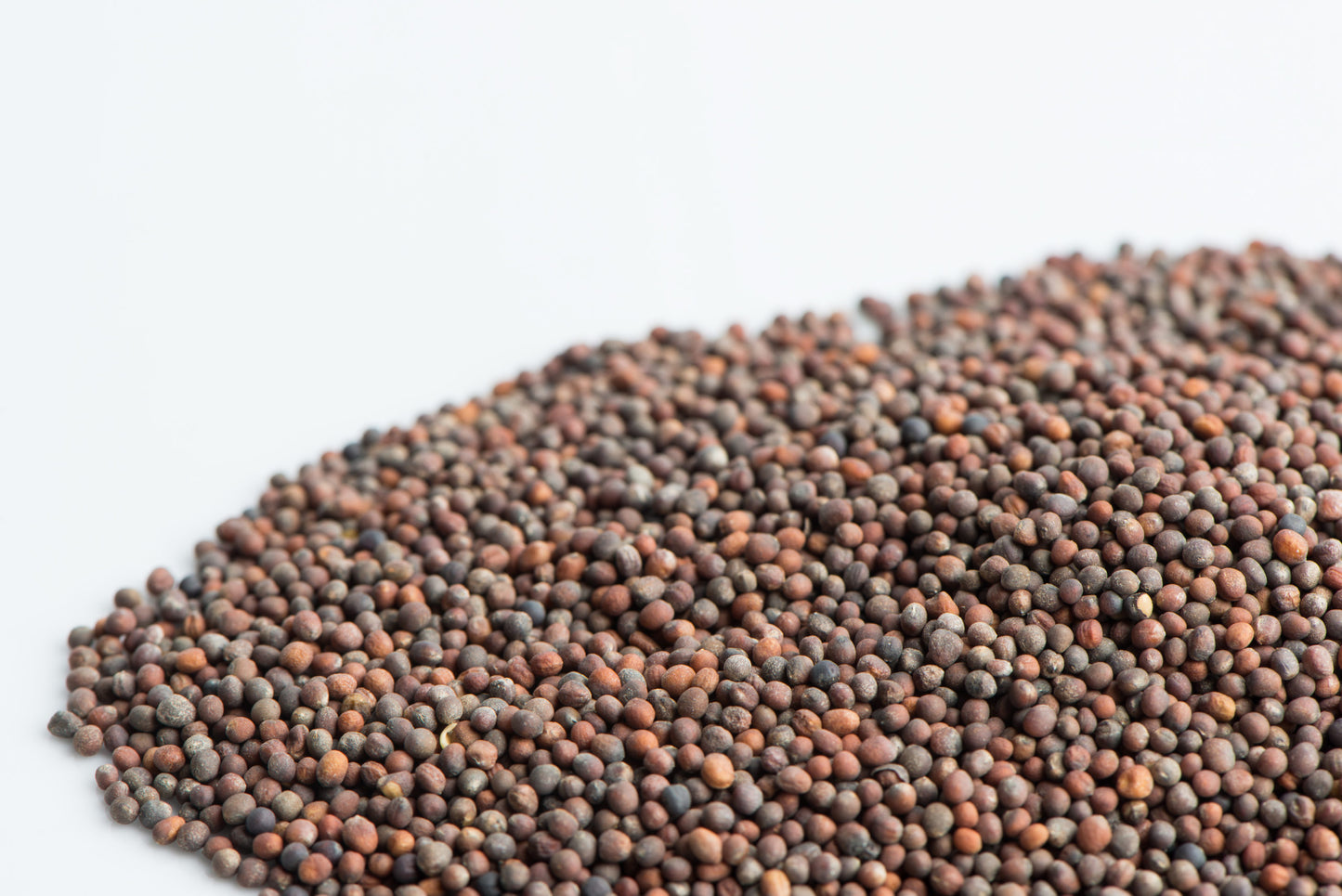
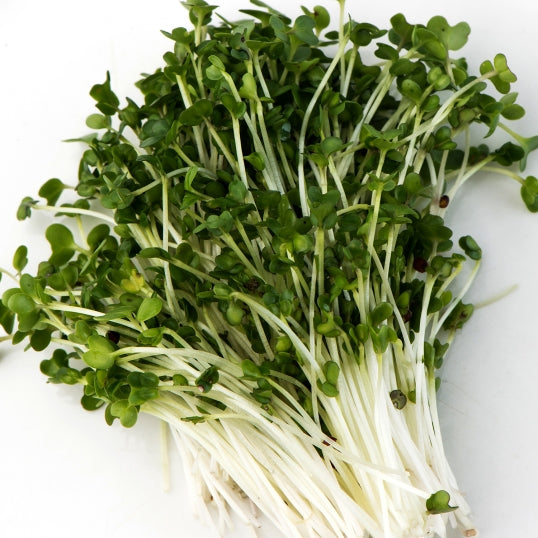
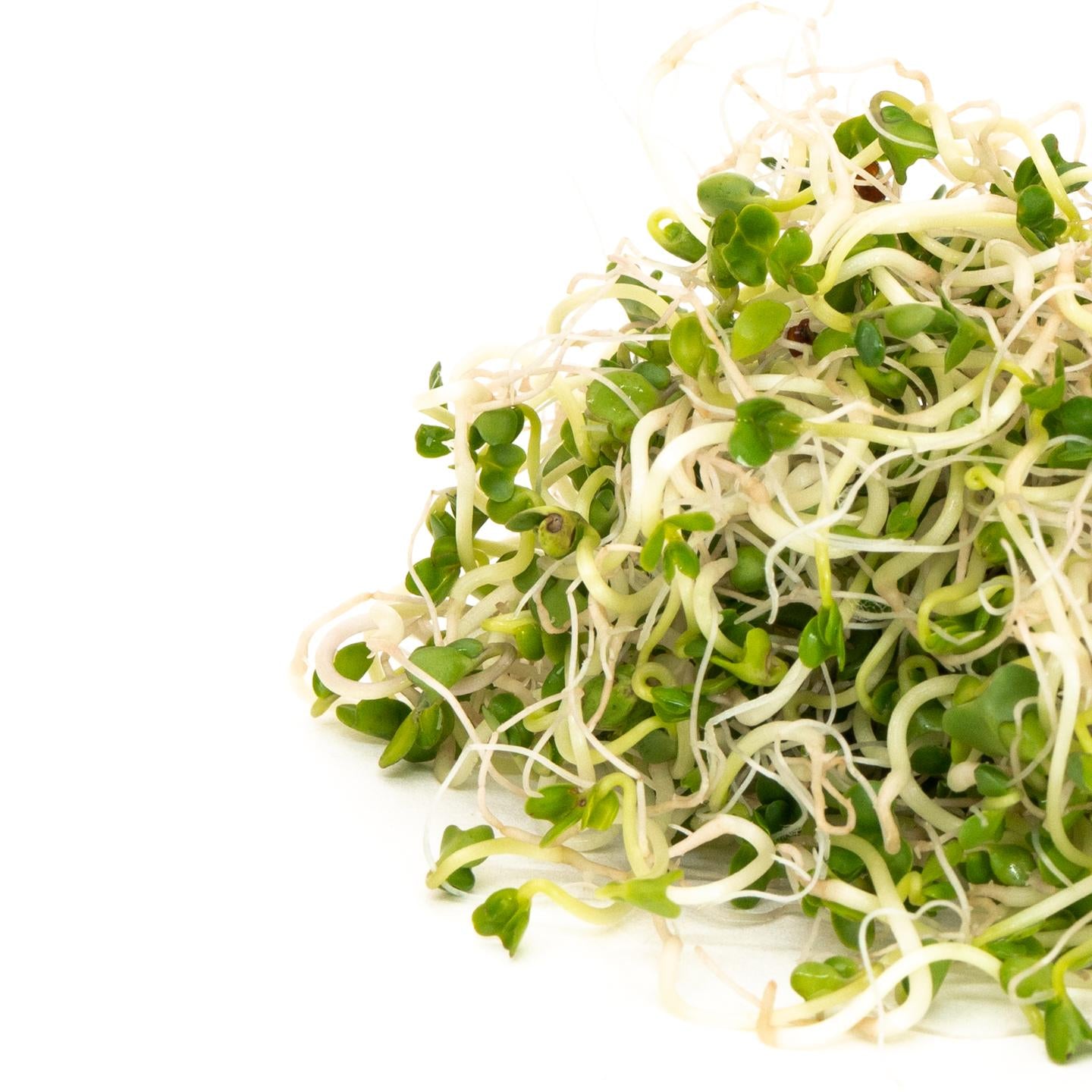
Let's Grow Together
We care deeply about people and the planet. As a second-generation family business, we go the extra mile to make sure you have a great growing experience. That means sourcing top-quality organic seeds—many from small farms here in Saskatchewan—and testing every lot in-house to ensure strong germination, cleanliness, and vibrant results. We're here to help you grow with confidence, every step of the way.
They grew super fast. I had batch ready in 4days. Delicious!
Love the seeds and have been successfully growing them now for years. The broccoli sprouts are amazingly fresh and delightful and quite easy to grow. It takes a few days have fresh sprouts with the sprouts themselves lasting 3 or 4 days before they are used up and time to start another cycle.
The seeds sprouted successfully. There are a few unsupported seeds that do not affect the overall taste. I am careful about the 2 hour soaking and twice a day rinsing. I find that 3 tablespoons seeds are too much and stick with 2 tablespoons. This is due to clumping of the broccolisprouts.
Really happy to find this company.The broccoli seeds were great and costumer service is excellent.
The broccoli seeds sprouted quickly and were ready to harvest on the 3rd day.

